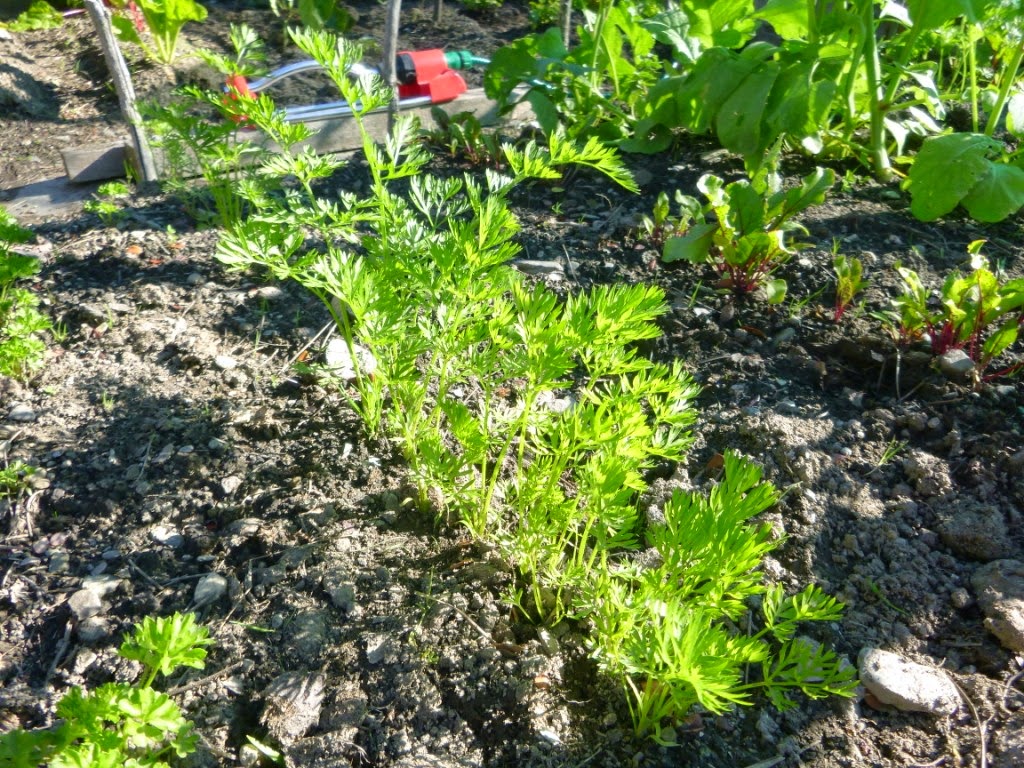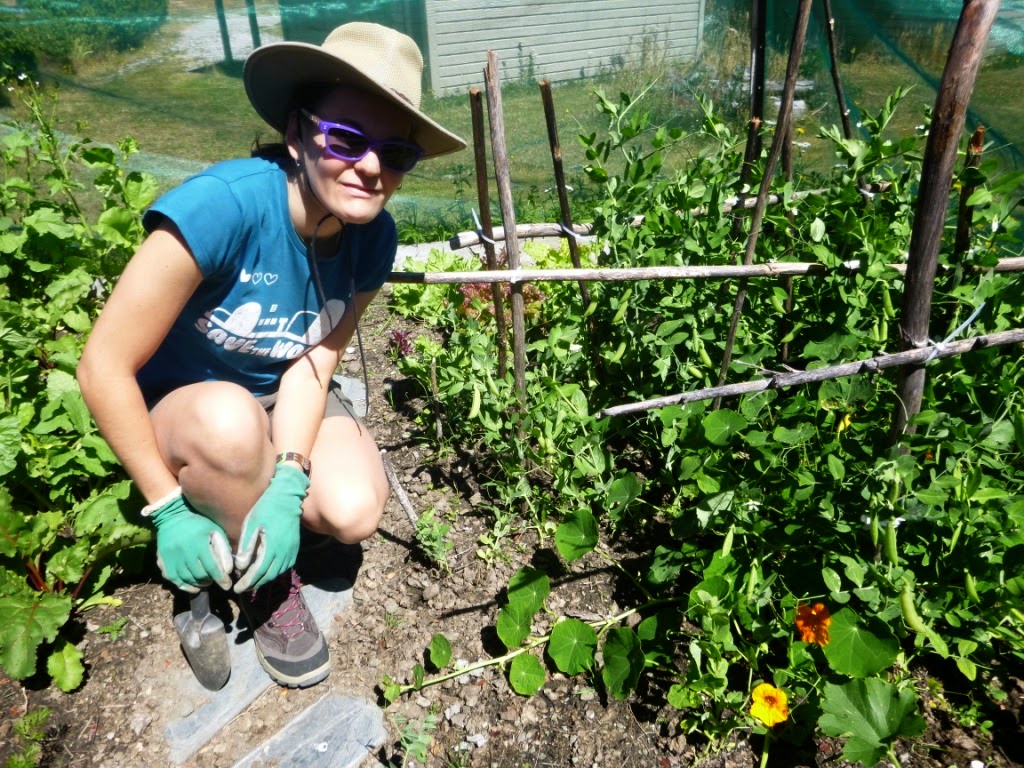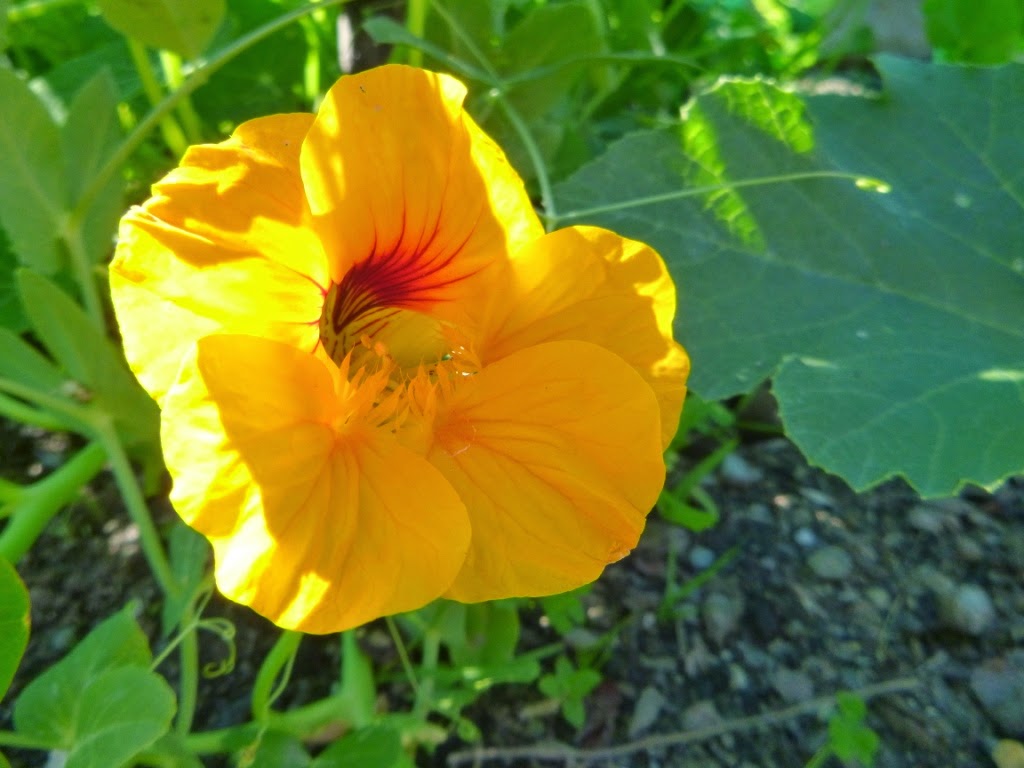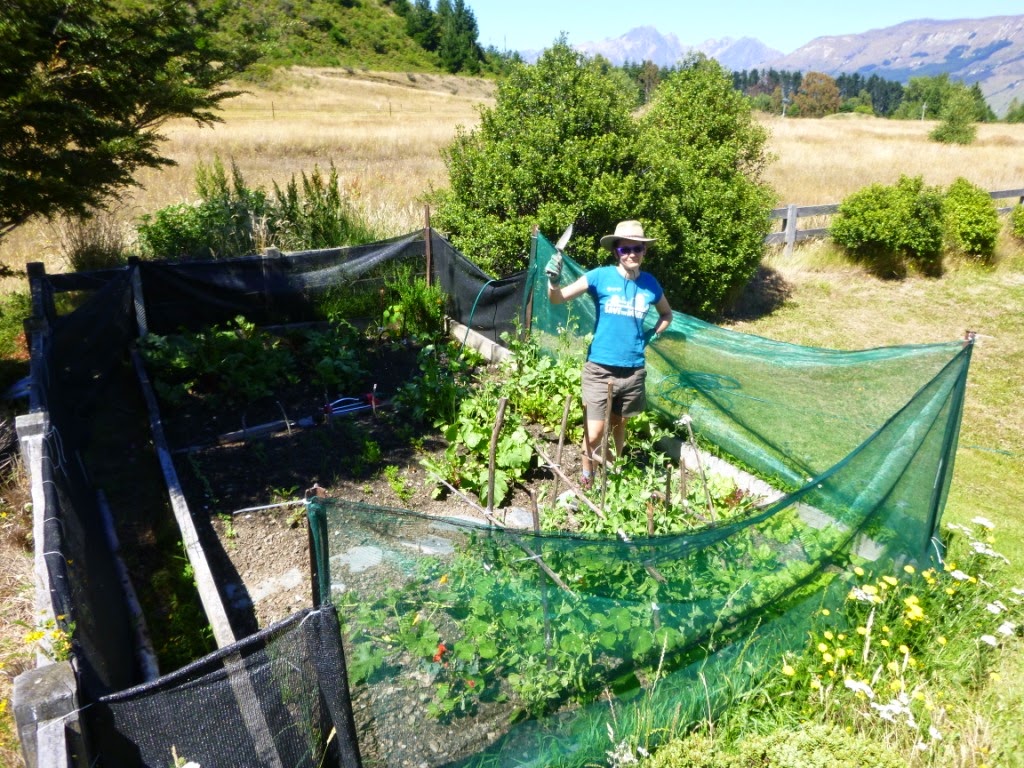Click here to read the English version
Enrique & Marina
English version
Enrique
& Marina
Después de unas cuantas
actualizaciones con la famosa sección de “las huertonoticias” como estrella del
blog, hemos decidido dedicar una actualización entera a este proyecto de
Marina. Y un poco mío también. Podríamos decir que, en referencia al huerto,
Marina es Batman y yo soy Alfred el mayordomo (nadie quiere ser Robin). O
Marina es el serio y taciturno Capitán Alatriste y yo soy Quevedo, el gruñón
secundario que gusta a todo el mundo.
Pues bien, ya sin más demora,
empezamos con esta crónica de una cosecha anunciada. Las fotos que preceden a
este párrafo son el antes y el ahora del parterre donde tenemos el huerto. Son
algo así como las fotos de gente que ha hecho dietas milagro en las que se ve a
una persona obesa a un lado y a la misma persona, esta vez con un cuerpo
escultural, al otro. En este caso no hay trampa ni cartón. La primera foto fue
tomada el 5 de abril de 2014, mientras que la segunda es del 24 de enero de
2015. Entre una y otra, mucho trabajo.
Tomates
Las tomateras empezaron creciendo
con mucha energía en el invernadero que teníamos en el porche, hasta que un huracán
lo derribó y hubo que trasladarlas dentro de la casa. Esto nos pasó dos veces,
ahora el invernadero es una estantería donde dejamos los zapatos y los
ordenadores.
Ahí siguieron creciendo a buen
ritmo, teníamos 25 tomateras. Llegó el día que decidimos sacarlas al exterior
con tan buena puntería que la primera noche heló. No sobrevivió ninguna.
Desastre. Un par de días después Helen, la profesora del colegio que me lió
para dar clases de castellano a los niños, nos dio una de las tomateras de su
invernadero y Mike y Kyomi, nuestros vecinos, nos dieron otra. Eran pequeñas
pero tenían la actitud adecuada.
Cuidar a estas dos tomateras está
suponiendo más trabajo que cuidar a un animal: por las noches duermen dentro de
la casa y los días que no hace sol no salen. En caso de que tengamos un día
soleado las sacamos al porche; el lugar donde las ponemos depende de la
dirección del viento, que aquí suele ser demasiado fuerte para ellas.
Gracias a estos cuidados y a
nuestras amigas las abejas ya falta poco para tener tomates maduros listos para
comer.
Lechugas
Las lechugas son las Ernest
Shackleton de las verduras. Resisten lo que les echen. Todas sobrevivieron al
colapso del invernadero, a un par de heladas e incluso a Anastasia, que se olvidó
de regarlas cuando apenas eran brotes y nosotros estábamos en Wanaka.
Nuestras lechugas son pitbulls.
Tenemos creciendo lechugas de diferentes tipos, pero no tenemos ninguna
favorita, queremos a todas nuestras hijas igual. Los semilleros que utilizamos
son hueveras de las que utilizan en Blanket Bay (30 huevos por cartón).
Una vez las lechugas ya parecían
lechugas las trasplantamos al huerto oficial o a las jardineras del porche.
Estas jardineras son las cajas de
porexpán en las que reciben el pescado en Blanket Bay. Marina y yo las hemos
ido cogiendo y pintando de colores, por eso de que queden bonitas en el porche,
y las utilizamos de jardineras.
Tenemos nueve lechugas en estas
jardineras caseras y otras doce en el huerto. Con el objetivo de tener un flujo
lechuguil contante ya tenemos otro semillero listo.
Acelgas
Plantamos acelgas rojas a la vez
que las lechugas y crecieron igual de fuertes y decididas.
Gran parte de ellas fallecieron
el día de la destrucción del invernadero y otras lo hicieron debido al descuido
de Anastasia.
Afortunadamente sobrevivieron
suficientes plantas como para tener acelgas para alimentar a todo Glenorchy
durante varios meses.
El proceso que seguimos fue el
mismo que con las lechugas y el resultado, similar: plantas grandes y fuertes
que se yerguen chulescas cuando el sol se pone al atardecer como diciendo “aquí
estoy yo”.
Rábanos
Los rábanos los plantamos
directamente en el huerto en líneas muy bien ordenaditas que el viento nos
fastidió.
Nos habían dicho que los rábanos
serían fáciles de cultivar y así fue, han crecido a la velocidad de la luz. Y
aquí viene el “pero”.
Hemos aprendido que tener un
suelo extremadamente nutritivo no es bueno y menos para las plantas de las que
nos comemos la raíz. Nuestro suelo es tan rico en nitrógeno (está formado
básicamente por caca de oveja y caca de caballo) que los rábanos no han tenido
necesidad de desarrollar sus raíces para hacer crecer sus hojas, por lo que
tenemos rábanos que parecen árboles pero que no tienen raíz útil para comer.
Alguno sí que nos ha salido
bueno, los hemos tenido blancos, morados y rojos. También hemos tenido uno
negro, pero ese estaba muy malo.
Remolachas y zanahorias
Plantamos las remolachas y las
zanahorias a la vez que los rábanos pero están siendo algo más tímidas.
Todavía no nos hemos podido comer
ninguna remolacha, pero la cosecha está próxima. En cuanto a las zanahorias, la verdad es que les está
costando bastante crecer.
Esperemos que no pase como con
los rábanos y acabemos teniendo un bosque de zanahorias y remolachas y ninguna
raíz jugosa que poner en la ensalada. Crucemos los dedos.
Pimientos
La velocidad de crecimiento de
los pimientos es extremadamente lenta, se lo están tomando con mucha calma.
Pero ahí están, conspirando para, de repente, florecer y crecer a lo bruto como
medusas en un océano lleno de mierda.
Los pimientos empezaron a crecer
tranquilamente en el invernadero, siguiendo la filosofía del “hakuna matata”,
sin prisas y con calma. Pensamos que ninguno había sobrevivido a la catástrofe
del invernadero porque no pudimos encontrar las plantas entre los escombros en
la zona cero. Los muy listos se escondieron dentro de la bolsa de tierra
especial para hacer crecer semillas. Se pasaron varios días a la sombra hasta
que la casualidad quiso que las rescatásemos. La verdad es que la sorpresa nos
alegró mucho.
Una vez consideramos que las
plantas eran los suficientemente resistentes como para no necesitar la
protección del porche las trasplantamos al huerto, en donde tenemos unas diez
plantas de diferentes tipos de pimientos (no hay de Padrón) con un solo
pimiento creciendo.
Si sobrevive hasta que esté en su
punto para comer lo vamos a pasear por Glenorchy en un cojín de terciopelo
rojo.
Perejil y albahaca
Famoso islote español que Dios
puso en la costa marroquí y también una hierba bien rica para aderezos, el
perejil: tenemos un montón creciendo y está tan bonito que da pena cortarlo y
comerlo.
Lo mismo pasa con la albahaca,
que es muy mona y nos servirá para hacer un pesto riquísimo.
De momento la hemos utilizado en
alguna que otra pizza que hemos cocinado.
Guisantes dulces
Plantamos los guisantes
directamente en el huerto y enseguida empezaron a crecer.
Luego tuvimos un par de semanas
soleadas y dieron el estirón. Son un tipo de guisantes que en inglés se conocen
como “sugar snap peas” y se comen enteros, vaina incluida, siendo muy dulces y
refrescantes.
Incluso yo me los como y no soy
fan de los guisantes.
Se comen crudos en ensalada y en
internet avisan de que hay que comerlos antes de que pasen 6 horas desde que se
cogen. Qué presión.
Pepinos y calabacines
Hace un par de meses plantamos
calabacines y pepinos. Tardaron un montón en nacer y un montón más en empezar a
crecer.
Una vez consideramos que eran los
suficientemente fuertes como para sobrevivir a la mudanza hasta el huerto los
trasladamos. Teníamos dos calabacines y dos pepinos. De las cuatro plantas dos
murieron a los pocos días, con tan mala suerte que no sabemos cuáles eran.
Así que ahora tenemos dos plantas
misteriosas creciendo que nos darán calabacines o pepinos. ¡Sorpresa!
Nasturtium
El nasturtium es una planta
comestible que da flores comestibles que son, además, bonitas.
Marina plantó tres de estas
plantas en el invernadero y salieron con mucha energía, al trasplantarlas al
huerto se apagaron un poco pero hace unos días explotaron y lo están invadiendo
todo. De momento están bajo control.
Rúcula, mostaza y cebollinos
En algunas de nuestras coloridas
jardineras tenemos plantada mostaza (no la famosa de Dijon) que crece muy
fácilmente. También tenemos rúcula, que ostenta el récord de crecimiento,
brotando al día de haberla plantado.
La tenemos plantada en dos
jardineras, una roja y una azul, situadas a ambos lados de una jardinera con
tomillo y orégano.
En cuanto a los cebollinos, costó
que crecieran, pero ahí andan orgullosos entre dos jardineras de perejil.
Cebollas rojas
Lo que aquí conocen como cebolla
española es la típica cebolla roja. Helen nos dio unas cuantas hace más de tres
meses y fue lo primero que pusimos en el huerto, con un poco de miedo de
confundirlas con malas hierbas al principio.
Así como quien no quiere la cosa
fueron creciendo y ahora están prácticamente listas para comer.
Melones y sandías
Desoyendo los consejos de toda la
comunidad hortícola de Glenorchy hemos decidido intentar cultivar melones y
sandías.
Todo el mundo nos dice que el
clima nos es adecuado y que el verano no dura lo suficiente; nosotros confiamos
en el calentamiento global y en el cambio climático gracias al cual parece que
los veranos se alargan. Plantamos 9 sandías y unos 50 melones y todos brotaron.
Poco a poco hemos ido eliminando los débiles e incluso trasplantando algunos de
ellos.
Tenemos un melón y una sandía en
una jardinera enorme que pintamos de color negro para que absorba el calor del
sol y aguante calentita durante la noche.
En el huerto tenemos una sandía y
dos grupos de melones que iremos eliminando hasta que sólo quede una de las
plantas. A ver si tenemos suerte y por lo menos sale un melón. Si todo sigue su
ritmo será a finales de marzo, lo que equivale a finales de septiembre en
España.
Y, si habéis llegado hasta aquí,
felicidades. Vamos a dejarlo ya que seguro que después de tantas verduritas
estáis todos deseando ir a comer un buen filetón, que desafortunadamente no
crece en los árboles.
Enrique & Marina
English version
THE GARDEN FEEDS US
After a few posts including the “Veggie patch bulletin” as the main
section, we’ve decided to devote an exclusive entry to this project of mine.
Well, and little bit of Enrique’s. We could say that, in terms of the garden, I
am Batman and Enrique’s Alfred the butler (no one wanted to be Robin).
So, let’s start with this chronicle of an announced crop. The two
pictures preceding this paragraph are the before and after pictures of the
section where we planted the plants. They’re like these pictures of miracle
diet adds in which extremely obese people poses on one side and then there’s
the same person on the other with a new sculptural body. In this case, there’s
nothing fishy. The first picture was taken on the 5th of April of
2014 while the second was on the 24th of January of 2015. Between
the two of them there’s simply a lot of work.
Tomatoes
Our tomatoes started growing strongly in the greenhouse we had on
the deck until the gale knock the plants down and we had to take the seedlings
inside. This happened twice, the second time the greenhouse was totally destroyed.
We had 25 tomato plants. Then, the day to take them out again came
and they were so lucky that, that first night, we had the first frost after
several weeks. Not even one survived. Disaster. After a couple of days, our
friend Helen (the teacher from the GY School who persuaded Enrique to teach
Spanish for the village kids) gave us a tiny tomato plant from her greenhouse.
Mike and Kiomi, our trackhopper neighbors, gave us another one that was bigger.
These two plants looked small but they had the right attitude.
Looking after these two plants is been more work than looking after
an animal: at night they sleep inside and when it’s not sunny they stay in too.
If the Sun is shining, then they can go on the deck in a sheltered position to
be protected from the wind. That means that if it’s too windy the plants also
don’t go out.
But, all this looking after them will pay off and, thanks to honey
bees too, we’ll soon get a tomato ripe enough to be eaten.
Lettuces
Lettuces must the “Ernest Shackleton” in the vegetable kingdom.
They’re tough as. All of them survived when the greenhouse collapsed and even a couple
of frosts.
These plants are like green pit-bull. They’re all different types,
but we don’t have a favorite one, we love all our children the same. We started
planting the seeds in egg cartons from work re-purposed as seed trays with 30
holes in them.
Once they looked a bit like lettuces we repotted some in the soil of
the patch and some others in containers we’ve got sitting on the deck.
These pots are the big polyestyrene boxes in which fresh fish gets
delivered to Blanket Bay. We’ve been collecting and painting them in different
colors, so they look cute on the deck, and we can use them as window pots.
Then, there’re nine lettuces growing on the deck and twelve in the
vegetable patch. To try to get a constant flow of fresh lettuces we have some
new seeds in a few seed-raising containers in case we need a second batch of
plants.
Red silver beet
We planted red silver beet at the same time as the lettuces and they
grew as strong and confident as the above.
However, a good percentage of them died the day that the hurricane
blew the greenhouse out. And another good share died too while we were in
Wanaka volunteering for Red Bull.
Luckily we have enough survivors to feed Glenorchy for two months.
The planting process we used was the same as for the lettuces and
the results are also very close: nice edible plants!
Radishes
Radishes went straight to the outdoor patch in thin perfectly
straight lines of seeds made accordingly to my OCD as you can expect. But, as
expected too, the marvelous Glenorchy wind ruined these perfect lines.
We had been told that radishes are easy to grow and so they’ve been,
they’re growing at the speed of light. And that’s the “but”.
Out of this, now we’ve learnt that a soil that is too rich is not
ideal, particularly to grow root vegetables. Our soil seems to be so rich in
Nitrogen (of course, it’s basically sheep and horse poo) that the radishes can
grow a massive foliage without being bothered to grow a half decent root. Then,
we have radish-trees with tiny-almost-inedible roots.
But not all is bad news, some of them have been nice and we have
them in white, purple and red. We even got a black one but that wasn’t very
tasty.
Beetroots and carrots
Both beetroots and carrots were planted at the same time as the
radishes but they’ve been way shyer than those.
We still haven’t tasted any beetroots but the harvest is coming son,
we can feel it. About the carrots, well, let’s just say they’ll be ready
sometime between this summer and the next.
Moreover, we hope not to end up with a beetroot and carrot forest and
not a single juicy root to cut for the salad. Fingers crossed.
Peppers
The growing speed of these particular plants should be considered as
unusually slow, they’re taking all the time in the world. But we think they’re
just planning a mass flowering explosion. Or at least that’s what we’d like to
happen.
We started planting the peppers in the greenhouse and they
germinated there following the “hakuna matata” philosophy. After the hurricane
catastrophe, we couldn’t find any pepper survivors in the wreckage left. But
somehow, these seedlings magically ended up in the bag of compost I have for
pots. They stayed there for a few days where it’s nice, warm and shady until I
went to pick some dirt and found them. I was very glad to discover their hidden
spot but now I can’t tell which peppers are hot and which are not.
After repotting the seedlings in containers and letting them grow a
bit more, the good weather came and we could take the plants to the veggie
patch. Now, we have about ten different types of pepper plants including some
hot varieties and only one fruit growing.
If it makes it to survive until it gets to a good size to be eaten,
we should better put it on top of a red velvet cushion and show it to everybody
in the village.
Parsley and basil
There’s a Spanish island in the coast of Morocco with the name of
Parsley but here we’re talking about the herb. I have heaps of parsley and it’s
so good looking that I feel sorry every time I go out with my scissors ready to
pick some to chuck into the salad.
We’ve got the same problem with the basil, so cute looking, that
eventually will become pesto.
So far, though, we’re using the basil mostly in our home made
pizzas.
Sugar snap peas
The pea seed went straight into the garden soil and they sprouted
very early.
Soon after that, we had a few very sunny weeks and the sprouts
quickly became little plants. Then, we had some rain and more sun again and the
little plants needed some sticks to climb to as they weren’t that little any
more. Pod and pea of this variety is sweet, crunchy and edible and don’t need
cooking.
Even Enrique, who is not a great fan of peas, happily eats them!
They’re delicious in the salad and Enrique’s found on the internet
that you should eat them within 6 hours after being picked. Interesting.
Cucumbers and zucchinis
About two months ago we planted a few zucchinis and cucumbers in a
fairly big container. They took ages to germinate and even longer to start
growing.
When the plants had a big-ish
size, we moved them to the garden too. By that time we had two cucumbers and
two zucchinis, which should normally be plenty. Two out of these four died just
a few days after and unfortunately I didn’t keep track of which plant was which
so I’m not totally sure if the survivors are zucchinis or cucumbers.
Summarizing, at the moment we have two mysterious plants growing in
the garden. Are they going to be cucumbers, zucchinis or are they going to turn
up to be weeds?
I’m almost sure, though, they’re zucchinis. The flowers definitively
look like zucchini flowers, but we’ll have to wait a bit more.
Nasturtium
Nasturtiums are edible plants that make edible flowers which, on top
of that, are beautiful.
When we had the green house I planted three seeds of them and they’ve
been doing really well all the time. I’ve been trying to always keep them
sheltered from the wind. They became a bit sad when they moved into the garden
but now they love their new location and they’re expanding like crazy. We’ve
got to keep an eye on this Nasturtium invasion.
Rocket, mustard and chives
In Vivian’s container (she painted this one in pink and yellow) we
planted mustard (is not the famous Dijon) which is very easy to grow. We also
have rocket that holds the record in fastest germination, sprouting the same
day that the seeds went in.
Our rocket is growing in two long planters, one red and one blue,
surrounding the herb pot with thyme and wild oregano.
And about the chives, I found them harder to grow that what I thought
was going to be but they finally made it and they look gorgeous between the
parley boxes.
Red or Spanish onions
What it’s known as Spanish onions in New Zealand or Australia isn’t
a type of onion that comes from Spain or is particularly popular for us. And,
of course, it’s not called Spanish onion in Spain. The only reason I’ve got
them in the garden is because Helen gave me some seedlings that she had
leftover. They were the first brave ones to go in the ground three months ago
and we hesitated to do so as we thought we may confuse them with weeds at the
beginning.
Without demanding much attention from anyone, they grew and grew and
now some of them are nearly ready to eat.
Melons and watermelons
Ignoring all advice from the whole Glenorchy community (and several
others from all New Zealand and the world), Enrique’s decided to try to grow
melons and watermelons in Glenorchy.
Everyone says the climate it’s not going to make it happen because
our summer is too short. But he trusts in global warming and that the climate
change will extend the summer months long enough. Thus, he planted 9
watermelons and 50 melons (James, thanks for the seeds you kept for him) and
all of them germinated. Enrique sometimes pulls the weak sprouts and moves the
best looking ones to the best spots.
He’s got a melon and a watermelon in a very big container painted in
black to catch as much heat as possible during the day and to keep soil and
water warm during the night.
In the patch, Enrique’s left a watermelon and group of melons that
will be slowly reduced to one plant. The strategy consists in pulling the weak
sprouts, so the one we finally keep is the strongest. If we’re very lucky, at
least we’ll get a melon. If we keep going at this speed, that’d happen by the
end of March. We’ll see who’s right, then.














































